Tiger grouper, Epinephelus fuscoguttatus, is a carnivorous fish that grows faster than either humpback grouper (Cromileptes altivelis) or coral trout (Plectropomus spp). However, industry development of this fish has been faced with several challenges, paramount of which has been a lower market price of cultured fish compared to wild-caught tiger grouper.
The reasons given by the buyers for the low price paid for cultured tiger grouper are that fish fed on commercial pelleted feeds have a different taste and relatively poor survival during transport from farm to market compared to wild fish. The validity of these claims has not been rigorously tested. An additional impediment to industry development has been the high and increasing cost of trash fish, which has been the traditional source of feed for culturing marine fish, including groupers.

Because of the decreasing price paid for tiger grouper, farmers must find ways to reduce production costs or turn to farming other, higher-value species. Feed is one of the biggest cost component in rearing tiger grouper and total reliance on feeding trash fish has many problems. Most important are poor feed conversion (as much as one third to one half of the trash fish is not actually consumed by the cultured fish), its variable nutritional composition, its susceptibility to spoilage because of inappropriate handling practices, risk of disease introduction and significant downstream environmental pollution1. Moreover, increasing competition between human and aquaculture usage of low value fish (i.e. so called trash fish) is not only increasing its price to the farmer but also impacting on the often poor fishing villages, where low value fish may be the most important source of protein for people.
For the above reasons, there was an urgent need to develop cost-effective and high performing compounded feeds that had less reliance on using trash fish and which would have lower environmental impacts. It was recognised that grouper previously fed on trash fish would not readily take a dry compounded (pelleted) feed and thus development of a moist feed acceptable to the fish was an important aspect of our feed development work. There was also a need to test the validity of the market’s perception that cultured tiger grouper were less desirable than wild caught fish. This article outlines the work that was carried out by the Research Institute for Coastal Aquaculture, Indonesia to address these issues. This research was part of a collaborative project funded by the Australian Centre for International Agricultural Research: Project FIS/2002/077: “Improved Hatchery and Grow-out Technology for Marine Finfish in the Asia-Pacific Region”. The work entailed a controlled sea cage experiment and an on-farm study as an active extension mechanism to gain adoption of rearing tiger groupers on compounded feeds. A taste panel assessment was commissioned in Hong Kong to compare the eating quality of cultured groupers fed either trash fish or compounded moist and dry feeds.
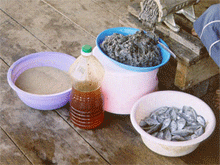
below: Figure 2. Homogenous mixing of all ingredients
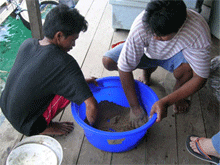
Comparison of Moist and Dry Compounded Feeds and Trash Fish
Methods
In this controlled sea cage experiment, five diets were compared when fed to juvenile tiger grouper over a 20-week growing period. Three of the diets were moist diets that examined the effect of reducing the amount of trash fish from a maximum of 50 per cent (on a dry matter basis) to zero; the fourth diet was a commercially manufactured dry pelleted grouper feed and the fifth diet was trash fish (Table 1). The critical chemical composition of these diets is shown in Table 2, while Table 3 gives the cost of these diets.
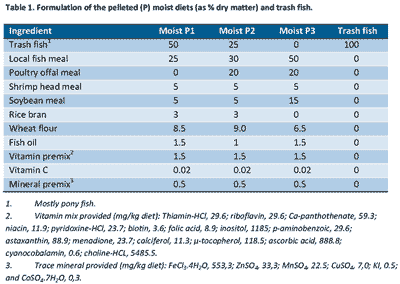
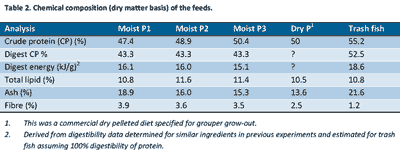

The making of the moist pelleted diets followed standard procedures: dry ingredients were thoroughly mixed together in a planetary mixer and fish oil slowly added while mixing continued. Trash fish was minced by passing it through a meat mincer several times and then mixed in with the other ingredients. For Moist P3 diet where no trash fish were used, sufficient water was added to form a dough of approximately 50 per cent dry matter content. The dough was cold extruded through the meat mincer with the size of the die plate being varied in accordance with the increasing size of the fish being fed. The freshly prepared moist feed was either fed directly or held in a refrigerator for not more than 24 hours. These manufacturing procedures are illustrated in Figures 1 to 4.
Fish for the experiment had been hatchery reared at the Gondol Mariculture Centre and transferred as fingerlings to RICA’s floating net cages at Awerange Bay, South Sulawesi. The fish were acclimated in a floating net cage for a couple of months. During the acclimatisation, the fish were trained to accept moist and dry pelleted feeds. A total of 240 fish were stratified by weight into three groups of average weights of 234±11.3, 269±11.6 and 318±16.6 g. Five fish from each group were randomly sampled for determination of initial whole body chemical composition. The remaining 225 fish were equally distributed (15 fish/cage) within size groups to 15 net cages of 1×1×2 (depth) m. Throughout the experiment, diets were carefully fed twice daily to apparent satiety.
At the conclusion of the 20-week feeding period, three representative fish from each net-cage were sacrificed to determine the chemical composition of the fish. A further two fish from each cage or six fish from each treatment were collected randomly and were sent to Hong Kong for independent taste panel assessment.
Results and discussion
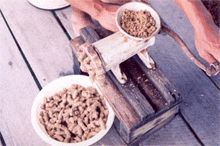
Except for the Moist diet P3 (which contained no trash fish) where fish survival was 80 per cent, survival of fish on all other diets was excellent, 91 to 98 per cent. However, there was no significant (P>0.05) difference in fish survival between treatments. Fish grew well on all diets with final weights ranging from 628 to 714g and significantly lower (P<0.05) only for fish fed Moist diet P3. Specific growth rate (SGR), feed conversion ratio (FCR, on as-fed and dry matter basis) and protein efficiency ratio (PER) of the fish are shown in Figure 5. The fish fed Moist diet P1, commercial diet (Dry P) and trash fish had high and relatively similar (P>0.05) SGR, FCR (as dry matter) and PER whereas these productivity measures were significantly worse for fish fed Moist P3; values for fish fed Moist Diet P2 were intermediate.
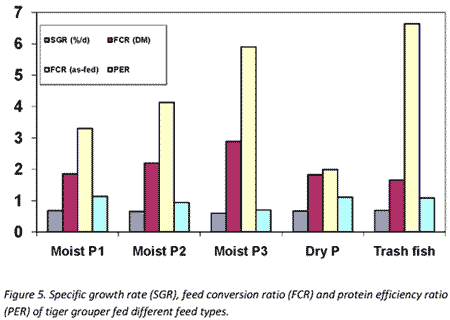
Poorer growth and FCR of fish fed Moist Diet P3 may be due to poor feed binding compared to the other moist pellet feeds, and consequently, resulted in high amounts of feed wastage. Moreover, Moist Diet P3 also contained a higher inclusion of soybean meal compared to the other two moist diets. Since soybean meal has a lower essential amino acid quality than fishmeal 2,3,4 and also contains anti-nutritional factors such as anti-trypsin and high phytic acid 5,6, these factors may have contributed to the poorer performance of fish fed the Moist diet P3. However, Rachmansyah et al.7 reported that soybean meal could be used in diets for humpback grouper, Cromileptes altivelis, at inclusion rates of up to 24 per cent in plant based diets as fishmeal replacements without adverse effect provided the feed was supplemented with 0.075 per cent phytase.
Although there were large differences between diets in the as-fed FCR, this difference was mostly due to differences in dry matter content of the diet (Table 2). When expressed on a similar dry matter basis, diets Moist P1, Dry P and trash fish all had similar FCRs which were significantly better than fish fed Moist Diet P3; DM FCR of fish fed Moist Diet P2 was intermediate.

The initial and final whole body chemical composition of fish is shown in Table 4. No significant differences were observed between diets for any of the analysed components. However, over the course of the 20-week experiment, there was a uniform increase in lipid content of about 2.5 per cent above that of the initial fish for all diets. It is interesting to note that although the five diets varied considerably in protein and energy contents (Table 2), the fish were able to accommodate these differences in nutrient supply, probably through moderation of appetite, to end up with almost identical final body composition. There is evidence that fish do have considerable homeostatic capacity to maintain whole body chemical composition within reasonably normal limits8.
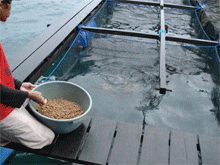
The least expensive feeds on an as-fed basis were Moist Diet P3 (US$ 0.32/kg) and trash fish (US$ 0.42/kg) while the most expensive was the commercial diet, Dry P (US$ 1.00/kg). However, when compared on a similar DM basis, the trash fish was the most expensive (US$ 1.67/kg) with the commercial Dry P and Moist P1 diets being the next most expensive (US$ 1.09/kg and 1.07/kg, respectively); the least expensive diets were Moist P2 and P3 (US$ 0.77/kg and 0.66/kg, respectively). These feed costs are based on the ingredient cost for the moist diets without any account of including an on-farm manufacture cost. However, the commercial Dry P diet was the actual cost of the diet as landed in South Sulawesi. When the feed cost to produce 1 kg of fish weight gain was calculated (Table 5), the most expensive feed was trash fish (US$ 2.77/kg fish gain), the least expensive was Moist P2 (US$ 1.72/kg fish gain) while Moist diets P1 and P3 and the commercial Dry P diet were all very similar (US$ 1.98, 1.90 and 2.00/kg fish gain, respectively). It must be recognized that these cost calculations do not take into account any differences in fish survival between diets. With the exception of Moist diet P3 where fish survival was low (80 per cent), survival on all other diets was high (91-98 per cent) and not significantly different. Looking at level of pellet production cost, practical use, feed stability and environmental compatibility, commercial pellet was more beneficial compared to other meals. However, if tiger grouper have not been adapted to accept dry feeds, it may be necessary to feed a moist diet to help fish to accept dry pellets9.

Eating quality of the cultured fish as determined by an independent taste panel in Hong Kong is summarised in Table 6. Fish fed Moist P2 tended to have better eating quality than fish fed other feeds, while the least attractive was fish fed Moist P3. It is difficult to relate differences in eating quality to chemical composition of the fish given the similarity for all diets (Table 4). However, fish fed Moist P2 had the highest protein and lowest lipid content compared to fish fed other feeds and whether this combined to produce fish with better eating quality is difficult to assess. Fish fed Moist P3 were noticeably thinner than those fed other diets and particularly those fed Moist P2. The taste panelists also commented that fish fed Moist P2 were superior in overall eating quality than grouper from Thailand and Taiwan. However, this was a very subjective opinion and no information was given about the condition of the fish that that opinion was based on. Overall, the eating quality of fish fed Moist P2 and P1 diets, the commercial Dry P and trash fish feeds was rated highly while only the fish fed Moist P3 was considered to be of inferior quality.
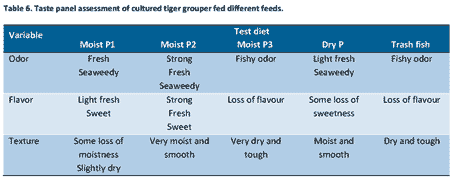
This study demonstrated that feeding Moist diets P1 and P2 and the commercial Dry P diet were equally good in rearing tiger grouper to market size and of excellent eating quality; surprisingly, fish fed the trash fish were not rated as highly while those fed Moist P3 were considered to be of inferior quality. In terms of feed cost to produce 1 kg of tiger grouper fish, the the Moist P2 feeds was the least expensive but it has a high handling/manufacturing demand on the farmer’s time. The commercial Dry P diet, though slightly more expensive than Moist P2, this extra cost could be more than offset by the convenience of continuity of supply, ease of storage and handling and least environmental impact. However, if tiger grouper have previously been fed on trash fish, they will only accept dry feeds after several days and possibly weeks of adaptation. This conditioning to dry feeds can be hastened by using moist feeds as an interim feeding practice, allowing the fish time to adjust to pellet feeding without any setback in the growth of the fish. Either of the Moist P1 or P2 diets would be ideal as transition or change-over feeds.
On-Farm Comparison of Feeding Trash Fish or Compounded Feeds
The objective of this study was to evaluate the feeding of a moist feed, a commercial dry feed and trash fish to tiger grouper on a commercial grouper farm. The farm was situated at Labuange Bay, Barru Regency at South Sulawesi.
Methods
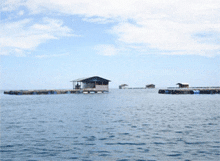
Three of the feeds that had been examined in the controlled sea-cage experiment, namely Moist P1, Dry P and trash fish were compared in this on-farm study. These feeds were made as described for the controlled sea-cage study and their formulation, chemical composition and cost are shown in Tables 1 to 3, respectively. Tiger grouper were blocked into two size groups of 240±22.7g and 305±33.6g and within these groups were randomly allocated to sea-cages of 2×2×2.5 (d) m at a stocking rate of 80 to 83 fish per cage. There were two cage replicates per treatment. The fish had been on the Labuange Bay farm for several months and were accustomed to being fed pelleted feed. During the 16-week study, fish were fed to apparent satiety once daily. At the conclusion of the experiment, a representative sample of three fish was taken from each cage to determine whole body chemical composition.
Results and discussion
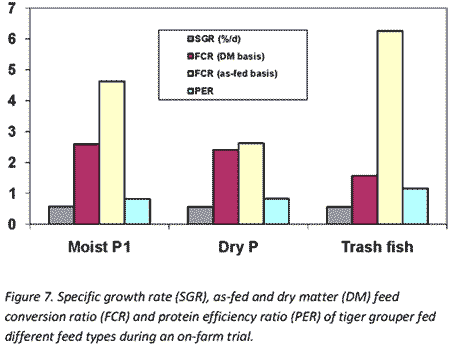
Fish survival during the experiment was 94-98 per cent and did not differ between treatments (P>0.05). Other productivity measures (Figure 7) also did not differ between treatments. The SGR of the on-farm grouper averaged 0.56 per cent/day, which was lower than that seen with the same feeds in the controlled sea-cage experiment where SGR averaged 0.68 per cent/day. Previous studies have shown tiger grouper of 165-263 g to grow at 0.66-0.72 per cent/ day 10 while smaller fish of 27 g start weight grew at 1.50-1.59 per cent/ day 11. Although expressing growth as SGR reduces the effect of fish size to some extent, it does not fully compensate for the relative change in metabolic demand as fish increase in size12.
As expected, the as-fed FCR of fish fed trash fish was much worse than for the other diets that had a higher concentration of dry matter. When compared on a similar dry matter basis, fish fed the trash fish had significantly better FCR than all other diets with the Moist P1 diet being significantly worse than all other diets.
The initial and final whole body chemical composition of representative fish is shown in Table 7. There were no significant treatment differences. However, during the course of the experiment, there was a uniform increase in body lipid from 6.8 per cent to ±8 per cent.
Using the same feed costs as for the controlled sea-cage experiment (Table 3), the feed cost to produce 1 kg fish weight gain in the on-farm study is shown in Table 8. Essentially, there was no difference in the tiger grouper production cost between the three feed types although the Moist P1 diet was slightly more expensive US$2.78/kg fish gain compared to US$2.62-2.63/kg fish gain for the commercial dry pellet and trash fish. Based on these results, the commercial dry pellet diet is the best to use because of its storage and handling advantages.
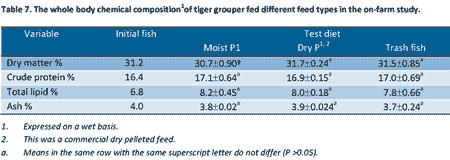

Conclusions
The on-farm experiment has demonstrated that tiger grouper fed the commercial dry pellet diet used in this work grew equally as well as fish fed trash fish and with an equivalent per kg fish production cost. Because of the practical handling and positive environmental benefits of feeding a dry pelleted feed, we see no reason why trash fish should continue to be relied upon as the sole source of feed for culturing grouper.
It is recognised that tiger grouper previously fed trash fish may not readily accept a dry pellet diet and may show little or no growth during this period of adaptation. This set back can be avoided by using a moist diet as a transition between feeding trash fish and dry pellet. The moist feed can be easily made on-farm using simple and inexpensive equipment. Our work has shown that our Moist P2 formulation (Table 1) that contained 25 per cent trash fish (on a DM basis) and 75 per cent of readily available dry ingredients was readily accepted by tiger grouper that had previously been fed only trash fish. In our controlled sea-cage experiment, fish fed Moist P2 survived and grew equally as well as those fed trash fish. Moreover, the feed cost of this moist diet to produce 1 kg fish gain was 60 per cent less expensive than feeding the trash fish (US$ 1.72 versus 2.77/kg gain, respectively).
An independent taste panel assessment of the eating quality of tiger grouper fed the moist, commercial dry or trash fish feeds examined in the controlled sea-cage experiment found all diets to be highly acceptable. Fish fed the moist diet that contained no trash fish (Moist P3) was considered to be slightly inferior to those fed other diets but this may have been due to these fish being thin and smaller than the other fish.
We recommend that tiger grouper should be fed a good quality commercial dry pelleted feed if only because of its positive environmental benefits over that of feeding trash fish. However, our controlled and on-farm experiments have shown that the commercial dry pellet feed is equally as cost-effective in rearing tiger grouper as feeding trash fish.
Acknowledgments
The authors thank Reni Yulianingsih, Makmur, Ramadhan and Rosni, Yohanes Teken for their technical and analytical assistance during the study. This work was part of an Australian Centre for International Agriculture Research (ACIAR) project (FIS/2002/077) to develop improved hatchery and grow-out technology for grouper aquaculture in the Asia-Pacific region. The financial support of ACIAR and the technical advice of the Project’s coordinator, Dr Michael Rimmer, Queensland Department of Primary Industries and Fisheries, are gratefully acknowledged.
References
- Sim, S-Y, Rimmer, M.A., Williams, K., Toledo J.D., Sugama K., Rumengan I., Phillips, M.J. A practical Guide to Feeds and Feed Management for Cultured Groupers. NACA. Bangkok, Thailand. 18 p.
- Stickney, R.R., Hardy, R.W., Koch, K., Harrold, R., Seawright, D., Massee, K.C., 1996. The effects of substituting selected oilseed protein concentrates for fish meal in rainbow trout Oncorhynchus mykiss diets. Journal of World Aquaculture. Society 27, 57–63.
- Davies, S.J., and Morris, P.C., 1997. Influence of multiple amino acid supplementations on the performance of rainbow trout, Oncorhynchus mykiss (Walbaum), fed soy-based diets. Aquaculture Research 28, 65–74.
- Biswas, A.K., Kaku, H., Ji, S.C., Seoka, M., and Takii, K. 2007. Use of soybean meal and phytase for partial replacement of fish meal in the diet of red sea bream, Pagrus major. Aquaculture 267, 284-291.
- Masumoto, T., Tamura, B., Shimeno, S., 2001. Effects of phytase on bioavailability of phosphorus in soybean meal-based diets for Japanese flounder Paralichthys olivaceus. Fishery Science 67, 1075–1080.
- Harland, B.F., Smikle-Williams, S., Oberleas, D. 2004. High performance liquid chromatography analysis of phytase (IP6) in selected foods. Journal of Food Composition and Analysis 17, 227-233.
- Rachmansyah, Usman, Makmur, Ahmad, T., 2005. Substitution of fishmeal with soybean meal in humpback grouper, Cromileptes altivelis, juvenile diets supplemented with phytase. Indonesian Fisheries Research Journal 11, 73-80.
- De la Higuera M. 2002. Effects of nutritional factor and feed characteristics on feed intake. In: Houlihan, D., Boujard, T., Jobling, M.(Eds.). Food Intake in Fish, pp. 269-296. Blackwell Science, Oxford, UK.
- Usman, Rachmansyah, Kamaruddin, dan Makmur. 2005. Growth response of tiger grouper (Epinephelus fuscoguttatus) fed moist pellet for grow-out in floating net cage. In: Rachmansyah, Sudaryono, A., Yuniharto D, Nadjib M. and Purnomo (Eds.). Proceedings of the Aquaculture National Converence. Makassar, 23-25 November, 2005, pp. 40-43. Badan Penerbit Universitas Diponegoro, Semarang. (In Indonesian).
- Usman, Rachmansyah and Kamaruddin. 2006b. Subtitution of fish meal with golden snail meal (Pomacea sp) in diets for grow-out of tiger grouper (Epinephelus fuscoguttatus). Jurnal Riset Akuakultur 1(2), 161-170. (In Indonesian).
- Usman, Neltje N. Palinggi, Kamaruddin and Rachmansyah. 2006a. Utilization of soybean oil as fish oil substitution in diet for tiger grouper, Epinephelus fuscoguttatus grow-out. Aquacultura Indonesiana 7(3), 165-171. (In Indonesian).
- Jobling, M. 1994. Fish bioenergetics. Chapman & Hall, London. 309 pp.
October 2009

